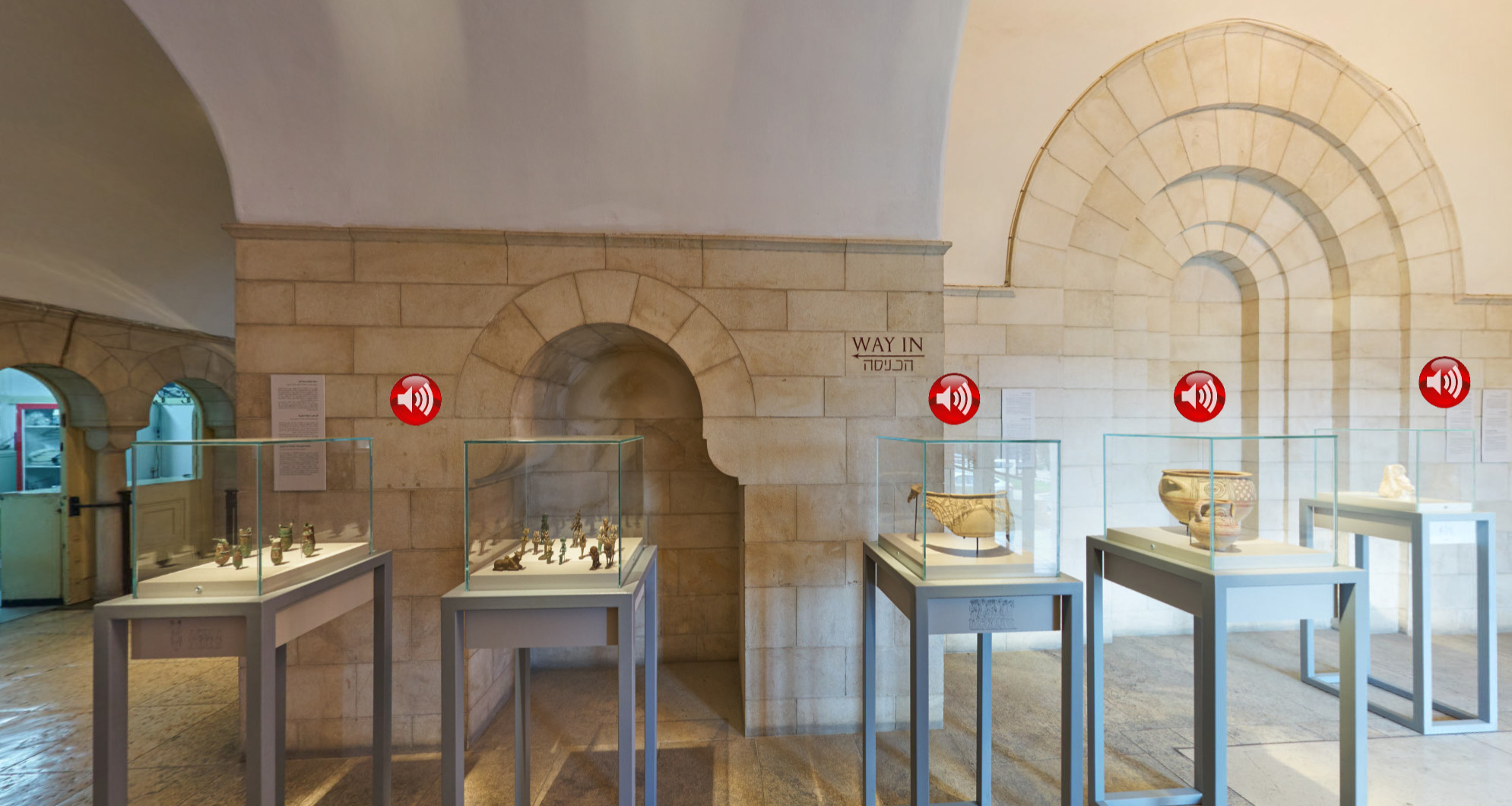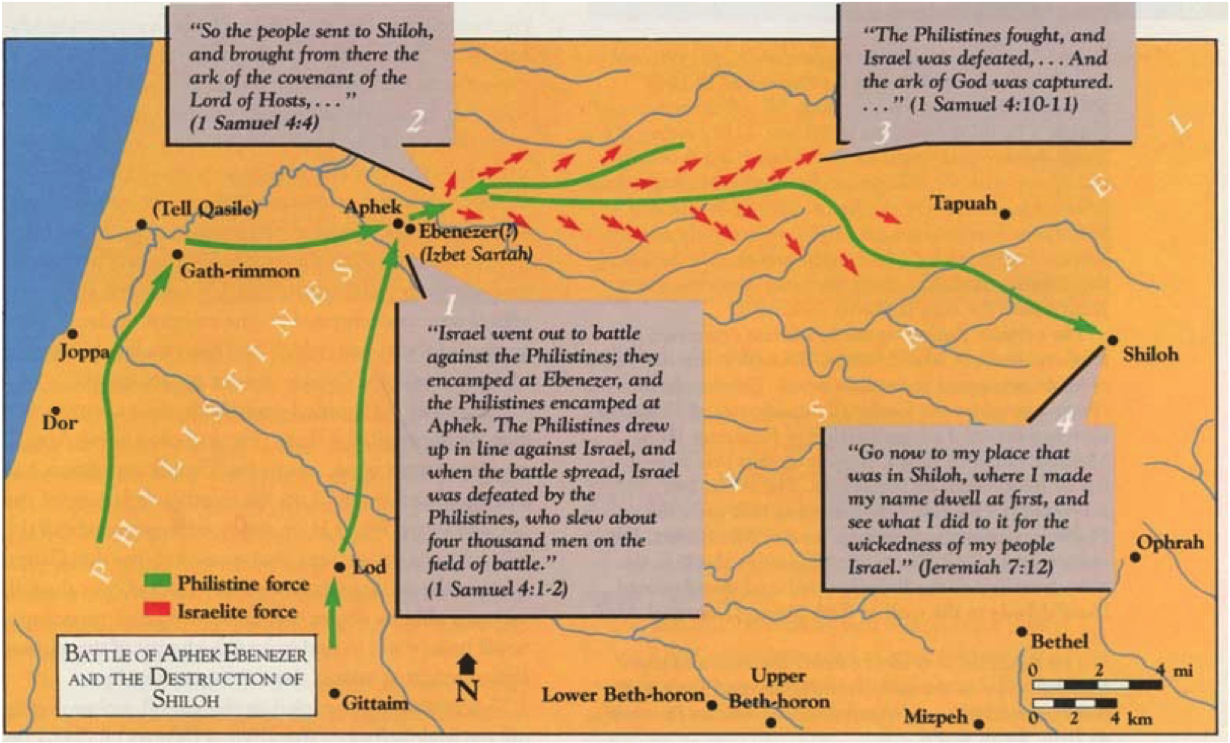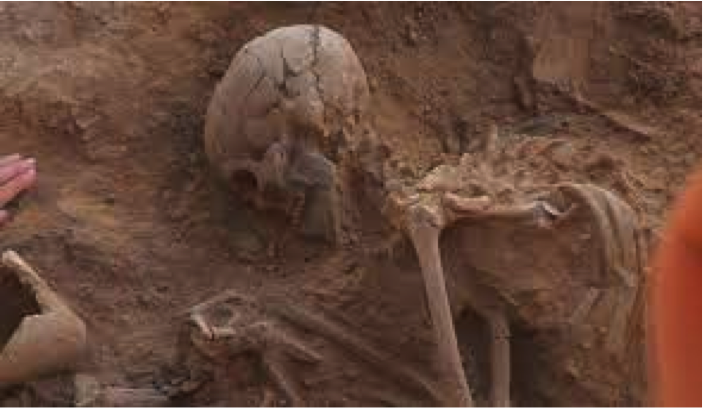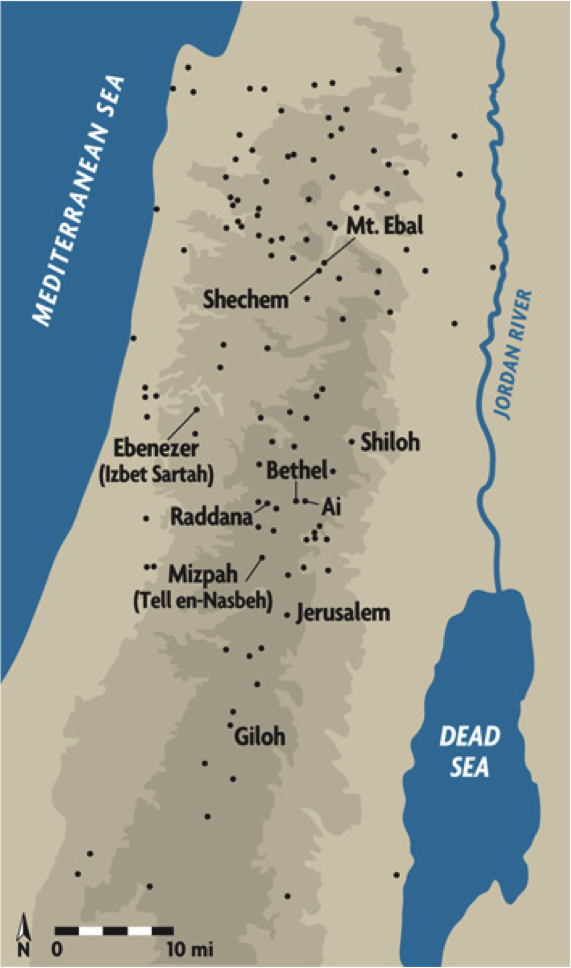1200-1100 BCE
From Joshua to Samuel

Israel Antiquities Authority
The Israelite Tabernacle at Shiloh,
1200 BCE
Joshua 18:1
“The whole community of the Israelite people assembled at Shiloh, and set up the Tent of Meeting there.”
Heritage Division of the Office of the Prime Minister of Israel, English translation courtesy of George Blumenthal

Biblical Archaeology Society
Rijksmuseum, Amsterdam
Museum Boijmans Van Beuningen, Rotterdam
The Philistines and the Collapse of the Bronze Age, 1200 BCE
Widespread famine and earthquakes along the Greek Islands and the southern coast of Turkey cause the Sea Peoples to attack Egypt, the “breadbasket” of the Mediterranean.  Wikipedia
Wikipedia

The Philistines Battle the
Egyptians 1175 BCE
Drawing based on sculpted reliefs at the Egyptian site of Medinet Habu depicts Egyptians in a sea battle with three different Sea Peoples—the Danunu, the Sikils and the Philistines, who originated from the area around Greece.
Yigael Yadin, The Art of Warfare in Biblical Lands

Ashkelon
Ashkelon: A Retrospective
Israel Museum Virtual Tour by Ardon Bar-Hama, Courtesy of George Blumenthal


Gemäldegalerie, Berlin
Städel Museum, Frankfurt
Pillar Bases of a Philistine Temple Discovered Near Tel Aviv
Judges 16:25-30
As their spirits rose, they said, ‘Call Samson here and let him dance for us.’ Samson was fetched from the prison, and he danced for them. Then they put him between the pillars.
…Samson called to the L-RD, "O L-rd G-D! Please remember me, and give me strength just this once…"
He embraced the two middle pillars that the temple rested upon, one with his right arm and one with his left, and leaned against them; Samson cried, "Let me die with the Philistines!" and he pulled with all his might. The temple came crashing down …

Israel Antiquities Authority
Battles With The Philistines and the Destruction of Shiloh
 Biblical Archaeology Society
Biblical Archaeology Society

City of David Megalim Institute, Courtesy of George Blumenthal and the Gol Family
The Philistines Capture the Ark of the Covenant
1 Samuel 4:10-11
The Philistines fought; Israel was routed, and they all fled to their homes. The defeat was very great, thirty thousand foot soldiers of Israel fell there. The Ark of G-d was captured...

Thirty days after Moses’ passing, the nation of Israel stood at the banks of the Jordan River. G-d had appointed Joshua to lead the nation into the conquest of Canaan and further promised Joshua that He will be with him as he was with Moses.
As the nation of Israel was slowly
settling into the land, G-d commanded them to establish His tabernacle – a
dwelling place.
The Tabernacle,
a portable tent of meeting, followed them throughout their journeys in the
wilderness. Now that
they were settling the land, a semi-permanent structure was built in Shiloh. The roof,
made of material, stretched over walls of wood and brick. Shiloh remained the
location of the Tabernacle and center point of worship for the majority of
years during the conquest of Israel.
One of the oldest and most relentless enemies of Israel throughout the Books of Judges and Samuel was the Philistines who lived on the western coastal planes. They are also mentioned by the prophet Amos:
“Have I not brought Israel up from the land of Egypt, and the Philistines from Caphtor [Crete]…”
– Amos 9:7
The Philistines were seafaring people whose origins trace back to the area today known as Greece.
Widespread famine and earthquakes along the Greek Islands and the southern coast of Turkey caused the Sea Peoples to attack Egypt, the “breadbasket” of the Mediterranean around 1200 BCE
You are looking at a drawing based on sculpted reliefs at the Egyptian site of Medinet Habu, depicting Egyptians in a sea battle with three different Sea Peoples—the Danunu, the Sikils and the Philistines. They invaded Egypt by sea and were defeated in a great battle called the Battle of the Delta.
The ancient city of Ashkelon has undergone the most in-depth
excavations of the pentapolis cities. The Leo Levy Expedition has
systematically outlined the ancient site's development from the time of its
origins to its final days.
Click
the button to view the virtual tour of the Ashkelon exhibit in the Israel Museum,
digitized by Ardon Bar Hama, narrated by Daniel M. Master, courtesy of George
Blumenthal.
The Philistines blinded and humiliated Samson and brought him to
the Temple of their god Dagon to sport with him in front of the leaders and a
great crowd of Philistines.
Judges 16:25-30 As their spirits rose, they said, ‘Call Samson here and let him
dance for us.’ Samson was fetched from the prison, and he danced for them. Then
they put him between the pillars. …Samson called to the L-RD, "O L-rd G-D! Please remember me,
and give me strength just this once…" He embraced the two middle pillars that the temple rested upon,
one with his right arm and one with his left, and leaned against them; Samson
cried, "Let me die with the Philistines!" and he pulled with all his
might. The temple came crashing down … those who were slain by him as he died
outnumbered those whom he slew when he lived.
In this picture are pillar bases of a Philistine Temple discovered
near Tel Aviv.
The greatest victory that the Philistines wrought was the
destruction of the Tabernacle in Shiloh and the capture of Israel’s most prized
possession – the Ark of the Covenant.
1 Samuel 4:10-11
The Philistines fought and Israel was defeated, …and the Ark of
G-d was captured.
The story of the destruction of Shiloh also introduces us to one
of the most powerful prophets and judges in Israel, the Prophet Samuel. Samuel
not only guided the Israelites through this turbulent time of Philistine
oppression but eventually appointed and anointed King David who would subdue
and conquer them.
The Ark, pulled by oxen, finally made its way back to the Israelites in Beit Shemesh, but even the Israelites had to learn to approach the Ark with deep reverence and fear. It found a temporary resting place in Kiryat-Yearim where it remained for twenty years. From there, King David transported the Ark to Jerusalem.
created with
WordPress Website Builder .


